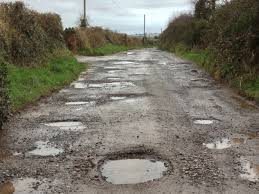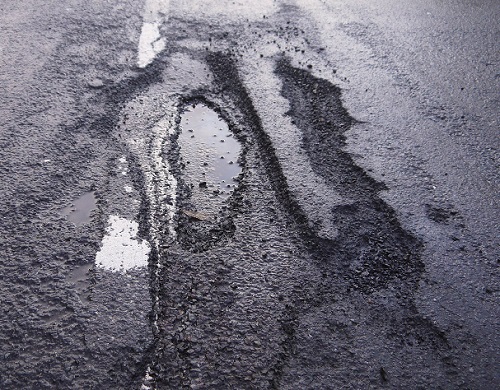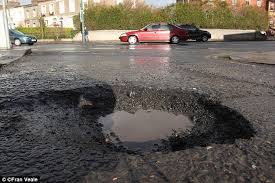We have long since suffered a pothole epidemic on Irish roads, so much so that it has become a running joke, and even lead to an outbreak of people ‘helpfully’ drawing attention to potholes by drawing, um, shall we say ‘male members’ around them.
Potholes really are no joke though, and they are emblematic of our crumbling road infrastructure. For all of the billions poured into private-public partnership motorways, a huge gap appeared in the road repair budget in the dark days of recession. Potholes and damage to verges went unrepaired, and while efforts have been made more recently to start rolling back the tide of neglect and ill-repair, the fact is that a great many of our minor roads, and indeed some of our major ones, are in a parlous state.
Impact on a car's health
 And potholes can be enormously damaging to the health of your car. The seemingly inexorable move to larger diameter alloy wheels and lower-profile tyres has made modern cars that much more vulnerable. Older cars, with comparatively big ‘balloon’ section tyres can better absorb the sudden impact with an unseen pothole, simply because there’s enough flex in the tyre to help take the shock.
And potholes can be enormously damaging to the health of your car. The seemingly inexorable move to larger diameter alloy wheels and lower-profile tyres has made modern cars that much more vulnerable. Older cars, with comparatively big ‘balloon’ section tyres can better absorb the sudden impact with an unseen pothole, simply because there’s enough flex in the tyre to help take the shock.
Lower profile tyres, with their short, stiff sidewalls have not such chance of taking an impact, and the effects can be disastrous. Frequently, it will result in a puncture, as the tyre’s bead is pulled away from the edge of the wheel, or the shape of the wheel itself is deformed, allowing the air to escape. With a large proportion of modern cars now eschewing heavy, space-robbing spare wheels and tyres in favour of ‘squirt-and-inflate’ repair kits, that means you’re going to be stranded as a can of tyre gunk isn’t going to do you any good if your wheel’s been bent out of shape.
More than just tyre damage
 Worse, much worse, can occur up to and including having an entire suspension unit ripped out of its mountings. Needless to say, this is far more likely to occur in wet conditions, when standing water on the road can disguise the size and severity of potholes, adding another layer of discomfort and even danger to the whole exercise.
Worse, much worse, can occur up to and including having an entire suspension unit ripped out of its mountings. Needless to say, this is far more likely to occur in wet conditions, when standing water on the road can disguise the size and severity of potholes, adding another layer of discomfort and even danger to the whole exercise.
The budget for road repair has been steadily and unpleasantly trimmed over the past few years, and many of the repairs which have been carried out are little better than the age-old ‘shovel some tar and chips into that and it’ll be grand’ routine. Clearly, with a damp, rainy climate such as ours, and the soft foundations under many rural roads, that’s never going to cut it, certainly not for long.
What comeback is there?
 The worrying thing is that you cannot necessarily claim compensation for any damage caused by a pothole from a local council, as many people believe you can. Speaking to The Irish Examiner, Cork’s city manager Tim Lucey recently outlined the fact that “not liable for damages for loss or personal injury for failing to repair potholes. Failure to do so comes within a defence of ‘non-feasance’ available to local authorities. He said no additional liability would be imposed on the council in relation to non-feasance, where a pothole had been identified and reported to it with a request for repair.” Mr Lucey said that the only occasion where a council could successfully be sued was if a repair was carried out to an identified pothole and it was shown that the repair was in some way negligent or inadequate. Which would seem to give councils all the excuse they need for not bothering to send out repair crews at all.
The worrying thing is that you cannot necessarily claim compensation for any damage caused by a pothole from a local council, as many people believe you can. Speaking to The Irish Examiner, Cork’s city manager Tim Lucey recently outlined the fact that “not liable for damages for loss or personal injury for failing to repair potholes. Failure to do so comes within a defence of ‘non-feasance’ available to local authorities. He said no additional liability would be imposed on the council in relation to non-feasance, where a pothole had been identified and reported to it with a request for repair.” Mr Lucey said that the only occasion where a council could successfully be sued was if a repair was carried out to an identified pothole and it was shown that the repair was in some way negligent or inadequate. Which would seem to give councils all the excuse they need for not bothering to send out repair crews at all.
Now, all of this has an effect on the history of a car, and it plays into our general concerns over mileage and where a car was bought and owned. Years ago, you would often have heard the prejudice that it was unwise to buy a car registered and driven in Kerry, because the roads there were reckoned to be worse than anywhere else in the country. That may well no longer be the case, but there’s no doubt that constant driving on badly-made roads accelerates the wear and tear of tyres, wheels, brakes and suspension components. You’d be wise, when looking into the history of any car, to check out where it was bought and mostly driven and factor that into your buying decision. Interestingly, it gives some of the advantage to higher-mileage cars, rather than lower-mileage ones. A car with lots of miles will, almost by definition, have been spending more of its time on major roads, which are more likely to be in good repair, so things like suspension and brakes should, by rights, be in better condition.
Which cars are most vulnerable
 Interestingly, Warranty Direct, a UK-based supplier of aftermarket warranties, has released a list of cars, rating the most and least vulnerable to damage from potholes, based on the cars being brought in for repair work to suspension, wheels and tyres. According to that data, the two best cars to buy if you live in a pothole-strewn area are a first-generation Ford S-Max (2006 to 2015) or a first-generation Nissan Qashqai (2007 to 2014). The cars apparently most susceptible to pothole damage were the Mercedes-Benz R-Class MPV (2006 to 2015) and the Saab 9-3 (2004 to 2012). Oddly, the next most susceptible were the Land Rover Discovery (2003 to 2010) and the Hyundai Santa Fe (2006 to 2012) although we wonder if those results were due to owners being complacent because they felt they were driving a big, tough 4x4. Warranty Direct managing director, David Gerrans, said: “The variation you see in suspension damage from one model to another is remarkable. Potholes are a major factor in causing axle & suspension failure and any vehicle regularly driven over impaired road surfaces or used for commuting over pothole-strewn routes will ultimately incur damage eventually. Components such as bushes, track rod ends, drop links, springs and dampers are all susceptible.”
Interestingly, Warranty Direct, a UK-based supplier of aftermarket warranties, has released a list of cars, rating the most and least vulnerable to damage from potholes, based on the cars being brought in for repair work to suspension, wheels and tyres. According to that data, the two best cars to buy if you live in a pothole-strewn area are a first-generation Ford S-Max (2006 to 2015) or a first-generation Nissan Qashqai (2007 to 2014). The cars apparently most susceptible to pothole damage were the Mercedes-Benz R-Class MPV (2006 to 2015) and the Saab 9-3 (2004 to 2012). Oddly, the next most susceptible were the Land Rover Discovery (2003 to 2010) and the Hyundai Santa Fe (2006 to 2012) although we wonder if those results were due to owners being complacent because they felt they were driving a big, tough 4x4. Warranty Direct managing director, David Gerrans, said: “The variation you see in suspension damage from one model to another is remarkable. Potholes are a major factor in causing axle & suspension failure and any vehicle regularly driven over impaired road surfaces or used for commuting over pothole-strewn routes will ultimately incur damage eventually. Components such as bushes, track rod ends, drop links, springs and dampers are all susceptible.”